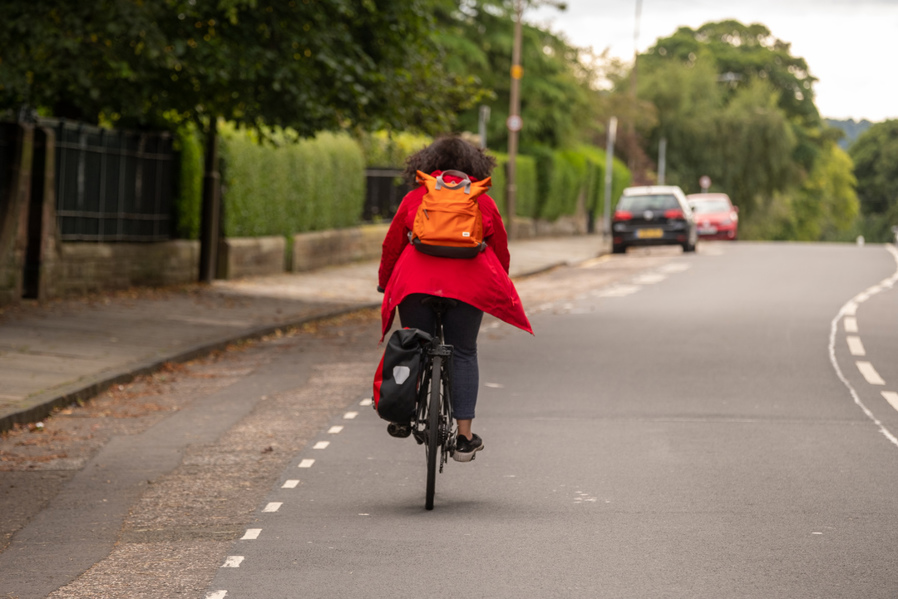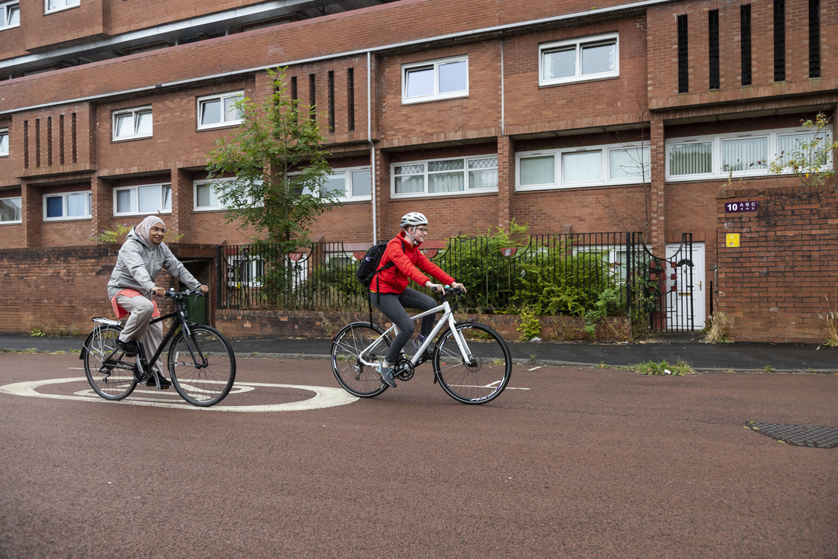
Key points
-
In collisions between bikes and vehicles, the person driving the vehicle is more often at fault (73% of factors contributing to a collision are assigned to the driver).
-
Collisions resulting in serious injury to people cycling happen in every part of Scotland
-
Wearing dark clothing while cycling is not a common cause of serious collisions
-
Engineering, education and enforcement measures are critical to reducing fatal and serious injuries in collisions involving people cycling.
The benefits of walking and cycling for people’s physical and mental health are well known. Over the next 5-10 years, a significant increase in cycling is expected, due to the investment in active travel, as outlined in Transport Scotland’s Cycling Framework for Active Travel, and more people choosing sustainable, affordable ways to travel. We cannot accept a corresponding rise in serious injuries (or worse) to people cycling and must take evidence-led action to avoid this.
Cycling Scotland recently analysed data published in Reported Road Casualties Scotland, the main source of injury collision data which is collected by the police from collisions attended or reported to them. It’s important to note that, although road safety data is improving, due to under-reporting and a new police collision recording system, data trends on serious injuries must be treated with caution.
What does the data tell us?
Collisions happen everywhere in Scotland
Between 2015 and 2021, 54 people cycling were killed and a further 1,836 were seriously injured in road collisions in Scotland[1]. Collisions occur in our cities and towns, as well as in rural areas and the islands, and in the summer months the number of journeys made by bike will rise, whether for work, commuting or leisure. All road users, across all our communities, have a responsibility for each other’s safety. Our national Give Cycle Space Campaign, which launched on 4th May this year, is designed to raise awareness of the risks posed to people cycling by illegal driving and is supported by Police Scotland, through delivery of Operation Close Pass in communities across Scotland.
Vulnerable road users are at greater risk of serious injury in a collision
The consequences of a collision between a pedal cycle and a motor vehicle will always be more serious for the person cycling, and this is reflected in the Highway Code’s Hierarchy of Road Users (Rule H1) which describes how ‘those in charge of vehicles that can cause the greatest harm in the event of a collision bear the greatest responsibility to take care and reduce the danger they pose to others.’
The current trend on serious injuries is difficult to state with confidence, due to historical under-reporting. The police moved to an injury-based reporting system in 2019, which provides a more accurate means of recording the type and severity of injuries suffered in collisions and is helping to address under-reporting but also means it’s difficult to assess trends over time. The data shows that in the two years from April 2020 to March 2022, 469 people suffered serious injuries in collisions while cycling. Of those, 23% involved a head injury and 52% involved a fracture, amongst a variety of serious injuries.[2]
What is very clear is that too many people suffer life-changing injuries while cycling, usually in a collision with a motor vehicle, and our first priority should be collision prevention, as the best way to reduce serious casualties.
Factors contributing to collisions
When a collision is reported to the police, the reporting officer records what, in their opinion, was the cause, choosing from a set list of contributory factors, which can be assigned to the location or to a particular road user involved. Analysis of the contributory factors recorded by Police for all collisions which resulted in fatal or serious injuries to people cycling between 2015 and 2021[3] helps us to better understand who is at fault and what some of the common causes of these collisions are.
The tables below show the top ten contributory factors assigned to cyclists (Table 1) and drivers (Table 2) in fatal or serious injury collisions between vehicles and people cycling, and the number of times each of these factors was assigned.
Table 1: Contributory factors where a person riding a bike contributed to or caused the collision
|
Contributory Factor - person riding bike |
Rank |
Number assigned to cyclists |
Total number assigned to all drivers/cyclists |
|
Rider failed to look properly |
1 |
138 |
512 |
|
Loss of control |
2 |
69 |
74 |
|
Rider failed to judge other person's path or speed |
3 |
58 |
191 |
|
Cyclist entering road from pavement |
4 |
54 |
59 |
|
Rider careless, reckless or in a hurry |
5 |
53 |
154 |
|
Poor turn or manoeuvre |
6 |
37 |
117 |
|
Travelling too fast for the conditions |
7 |
24 |
30 |
|
Slippery road (due to weather) |
8 |
23 |
29 |
|
Cyclist wearing dark clothing at night |
9 |
19 |
22 |
|
Disobeyed Give Way or Stop sign or marking |
10 |
17 |
37 |
For the person cycling, the data shows that failed to look properly is the most common contributory factor, followed by loss of control. The data also highlights that wearing dark clothing at night or not displaying lights at night are not frequently recorded as the cause of a collision, and in fact causes attributed to poor behaviour on a bike are more frequent.
Loss of control is a cause primarily assigned to people cycling and is more common in Scotland than in the wider Great Britain data, along with slippery road (due to weather). There are several reasons that might cause a person riding to lose control, such as the condition of the road surface, a near-miss by a motor vehicle, inexperience or the changeable Scottish weather.
Table 2: Contributory factors where a person driving a vehicle contributed to or caused the collision
|
Contributory Factor – person driving a vehicle |
Rank |
Number assigned to drivers |
Total number assigned to all drivers/cyclists |
|
Driver failed to look properly |
1 |
374 |
512 |
|
Driver failed to judge other person's path or speed |
2 |
133 |
191 |
|
Driver careless, reckless or in a hurry |
3 |
101 |
154 |
|
Too close to cyclist, horse or pedestrian |
4 |
92 |
93 |
|
Poor turn or manoeuvre |
5 |
80 |
117 |
|
Dazzling sun |
6 |
57 |
64 |
|
Disobeyed Give Way or Stop sign or marking |
7 |
20 |
37 |
|
Stationary or parked vehicle |
8 |
15 |
26 |
|
Aggressive driving |
9 |
14 |
15 |
|
Vehicle door opened or closed negligently |
10 |
12 |
12 |
Behaviours which describe dangerous or careless driving are the most frequently cited contributory factors in relation to people driving, the top five being: driver/rider failed to look properly; failed to judge other person’s path or speed; careless, reckless or in a hurry; too close to cyclist, horse, or pedestrian; and poor turn or manoeuvre.
Seventy-three percent (73%) of these contributory factors are assigned to the driver of the vehicle in collision with the person cycling and, in particular, the person driving failed to look properly more than twice as many times as the person riding the bike.
Whilst this data is a good indicator of the contributory factors that cause collisions, we must also acknowledge its limitations, as it does not capture collisions or incidents not reported to the police or near-misses. This is especially relevant for cycling, and research undertaken by the Glasgow Centre for Population Health[4] highlights how the large extent of under-reporting, especially for minor injuries, is limiting our understanding of the problem.
All road safety stakeholders need to use the best evidence available, acknowledge where there are gaps in the data, and work together to develop high quality evidence from existing and new data sources.

Challenging myths about cycling
The official data helps us to challenge some of the myths about people on bikes, particularly about the causes of collisions and how to reduce the likelihood or severity of the collisions.
In collisions between bikes and motor vehicles, the person driving the vehicle is more often at fault than the person riding the bike. Wearing dark clothing or failing to use lights are not common causes attributed to people cycling when involved in a collision. Poor driving or riding standards are a much more significant cause of collisions, and it would therefore be ineffective to prioritise action primarily on what someone cycling wears, rather than improving road user behaviour.
What do we need to do?
Scotland’s Road Safety Framework sets targets for reductions in casualties by 2030 and aims to reduce the number of people on bikes killed or seriously injured by 20%. The perception of road danger is frequently highlighted as a major barrier to more people taking up cycling. Collisions happen across Scotland and if we are to make our roads safer for people on bikes and enable more people to cycle, we must continue to work together to prevent collisions first and foremost, followed by measures aimed at reducing injury severity.
This can be achieved through a combination of engineering, education, and enforcement:
- Engineering is the top priority and the development of a cycling network, separate from motorised traffic, is the best way to deliver a safer environment for people cycling.
- Education and training must also remain a high priority to improve the skills and behaviours of all road users, of all ages, with the aim of reducing the risks posed to vulnerable road users.
- Enforcement will continue to have a vital role in tackling the behaviours that place people on bikes and other road users in danger. The use of technology, such as an online public portal for remote reporting of illegal behaviours supported by digital video evidence, is key to maximising opportunities to improve safety for all road users. The police can’t be everywhere but the public can.
These actions need to be prioritised across Scotland now, informed by the best available evidence, in order to reduce road danger, enable more people to travel by bike safely and meet Scottish Government’s long-term goal of Vision Zero - where no one is seriously injured or killed on our roads by 2050.
Cycling Scotland's analysis of this road safety data was featured in The Herald on 15 July 2023.
[1] Reported Road Casualties Scotland 2021 (serious injury figures adjusted following introduction of police CRASH collision recording system in 2019)
[2] Police Scotland management information
[3] Transport Scotland FOI request
[4] Cycling in Scotland: a review of cycling casualties, near misses and under-reporting (2020), Glasgow Centre for Population Health